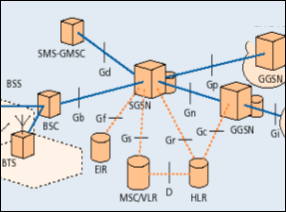Exercise 3.8: General Packet Radio Service
In the $\rm GSM phase \ 2+$ the GSM extension $\rm GPRS$ $($"General Packet Radio Service"$)$ was developed and standardized to improve data services. This
- supports several transmission protocols,
- offers packet-oriented data transmission,
- allows users to communicate with foreign data networks, e.g. the "Internet".
A GPRS mobile subscriber benefits from shorter access times and the higher data rate compared to data transmission in traditional GSM or HSCSD, which also emerged in the "$2+$" standardization phase.
Before the introduction of GPRS, some modifications and additions to the GSM network were necessary:
- In order to integrate GPRS applications into the existing GSM system architecture, "serving GPRS support nodes" $\rm (SGSN)$ and "gateway GPRS support nodes" $\rm (GGSN)$ had to be implemented $($see diagram$)$.
- For GPRS, up to eight time slots can be combined $($"multislot capability"$)$. In addition, four coding schemes with different data rates are defined as $\text{CS - 1}$ $($with $9.05\ \rm kbit/s)$, ... , $\text{CS - 4}$ $($with $21.4 \ \rm kbit/s$).
- For convolutional coding, a code of rate $1/2$ is used, which doubles the $294$ bits to $588$ bits. Finally, by puncturing $132$ bits, one arrives at bursts of length $456$ bits. Considering the frame duration of $20 \ \rm ms$ this results in the bit rate $22.8 \ \rm kbit/s$.
- The first thing a GPRS cell phone does when it is switched on is to perform a "cell selection". If a frequency channel with GPRS data is found, then the GPRS services can be accessed depending on the cell phone class.
- A distinction is made between three classes of terminal devices. A cell phone of the class $\rm C$ must be manually switched to GPRS services. In contrast, switching between GPRS and GSM happens automatically and dynamically for class $\rm A$ and $\rm B$.
Hint:
- This exercise belongs to the chapter "Further Developments of the GSM ".
- The above graphic is taken from the article mentioned below. We thank the authors for the release:
- Bettstetter, C.; Vögel, H.J.; Eberspächer, J.: GSM Phase 2+ General Packet Radio Service GPRS: Architecture, Protocols, and Air Interface.
In: IEEE Communications Surveys & Tutorials, Vol. 2 (1999) No. 3, S. 2-14.
- Bettstetter, C.; Vögel, H.J.; Eberspächer, J.: GSM Phase 2+ General Packet Radio Service GPRS: Architecture, Protocols, and Air Interface.
Questions
Solution
- With "GPRS", packet-oriented data transmission was realized for the first time.
(2) Correct are the proposed solutions 1 and 3:
- In order to integrate GPRS, the existing GSM system architecture had to be extended by "GPRS Support Nodes" $\rm (GSN)$.
- A distinction is made between "Gateway GSN" $\rm (GGSN)$ and "Serving GSN" $\rm (SGSN)$, which communicate with each other over an IP-based GPRS backbone network.
- SGSN is responsible for mobility management and performs a similar function for packet data services as the "Mobile Switching Center" $\rm (MSC)$ does for connection-oriented speech transmission.
- GGSN, on the other hand, is the interface to the supported foreign packet-oriented data networks.
(3) Correct are the proposed solutions 1 and 2:
- The first thing a GPRS cell phone does when it is turned on is to perform a "cell selection" by searching for a frequency channel containing GPRS data.
- A cell phone of class $\rm C$ must be manually switched to GPRS services afterwards.
- Automatic and dynamic switching between GPRS and GSM is only possible with a class $\rm A$ or $\rm B$ cell phone.
(4) Correct are the answers 1 and 3:
- With GPRS, up to eight time slots can be combined $($"multi-slot capability"$)$.
- The uplink and the downlink are allocated separately and the physical channels are reserved only for the duration of the transmission of data packets and then released again.
(5) In GPRS, up to eight time slots can be combined.
- With the coding scheme $\text{ CS-4}$, which, however, is only used with a very good channel, the data rate per time slot is $21.4 \ \rm kbit/s$.
- This allows a maximum gross data rate of $21.4 \ {\rm kbit/s} \cdot 8 \hspace{0.15cm}\underline{ = 171.2 \ \rm kbit/s}$.
(6) For convolutional coding, a code with code rate $R_{\rm C} = 1/2$ is used. This doubles $294$ bits to $588$ bits result.
- After that, $132$ bits are punctured, so that finally a code word of length $456$ bits.
- This gives a resulting code rate of convolutional code including puncturing of about $R_{\rm C}\hspace{0.05cm}' = 294/456 \hspace{0.15cm}\underline{ = 0.644} \approx 2/3$.
(7) The net data rate of a GPRS user is exactly the same as the net data rate of a GSM user:
- This is $456 \ {\rm bit}/20 \ \rm ms$ per speech frame ⇒ $R_{\rm net} \underline{= 22.8 \ \rm kbit/s}$.
